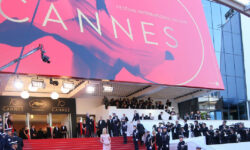Prof. Dr. Eser: I see that the motif in the Seljuk masterpiece is perceived as a cross, but this has nothing to do with reality.
Prof. Dr. Erdal Eser about the motif resembling a cross that was plastered with concrete 44 years ago and unearthed after 9 years of restoration work in Divriği Great Mosque and Darüşşifa, which was built during the Anatolian Seljuk State in Sivas, said, “Sometimes I see that this motif is described and perceived as a cross motif, but this has nothing to do with reality. Here, rather than being a cross motif, it is intended to emphasize the pulpit, which is an architectural element symbolizing the Prophet Muhammad, and therefore the Prophet Muhammad. Every time we see a plus sign, we see it as a cross, but this is not true.”
Divriği Great Mosque and Darüşşifa, which was built by Ahmet Şah, the son of Süleyman Şah, and his wife Melike Turan Melek in 1229 during the Mengücek Principality period of the Anatolian Seljuk State in Sivas’ Divriği district, was opened on May 6 after 9 years of restoration. In the Divriği Great Mosque and Darüşşifa, which is on the UNESCO World Cultural Heritage list, it was revealed that a motif resembling a cross on the ceiling above the mosque pulpit was plastered with concrete during the maintenance-repair works carried out in the 1980s.

The motif, which was removed from the concrete plaster using laser method and a very sensitive work, was unearthed again after 44 years. After the examination, the motif, whose original color was determined, was painted and started to be exhibited in accordance with the original. Prof. Dr. Erdal Eser, Faculty Member of Sivas Cumhuriyet University Faculty of Letters, Department of Art History, made statements about the motif, which those who saw it in the district resembled a cross because it was covered with concrete plaster.
‘IT IS MEANINGFUL THAT IT IS PLACED RIGHT IN THE MIDDLE OF THE AREA ABOVE THE MITER’
Prof. Dr. Erdal Eser stated that during the restoration process, new decorations were unearthed from many points of the building and said that the newly found motif on the pulpit, which resembles a cross, is the most striking motif. Prof. Dr. Eser said, “Sometimes I see that this motif is described and perceived as a cross motif, but this has nothing to do with reality. The motif on the cover covering the area where the minbar is located is among the compositions used by Asiatic societies to emphasize the center by using the four main directions.

Rather than being a cross motif, it is intended to emphasize the minbar, which is an architectural element symbolizing the Prophet Muhammad, and therefore the Prophet Muhammad. I find it meaningful that this motif is placed in the center of the area directly above the pulpit.
I accept this application as an application made to emphasize the importance of the pulpit and to show that the Prophet Muhammad is a gathering and central character. Every time we see a plus sign, we see it as a cross, but this is not true.”
Source: DHA












